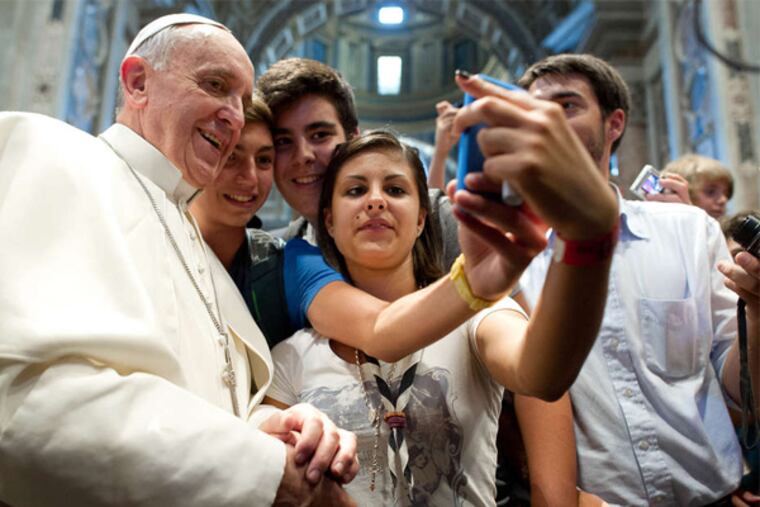The meaning of the ubiquitous selfie
It was a big year for the word selfie, even bigger for what it denotes: a photographic self-portrait, most often by mobile-phone camera. The term implies that you do more than take it. You post it to Twitter, Facebook, Instagram, as social networking. You can take it or someone else can. You can be alone or in a crowd. It just have to have yourself in it.

It was a big year for the word selfie, even bigger for what it denotes: a photographic self-portrait, most often by mobile-phone camera. The term implies that you do more than take it. You post it to Twitter, Facebook, Instagram, as social networking. You can take it or someone else can. You can be alone or in a crowd. It just has to have yourself in it.
Selfie has been declared "word of the year" by august sources including NPR linguist Geoffrey Nunberg, and by the Oxford Dictionaries (which reported that the usage of selfie has exploded 17,000 percent since 2012). It's in the U.S. version of the Oxford dictionary and is being considered for the OED. Its first documented print appearance was in a 2002 Australian chat room.
Celebs have taken them ever since mobile phones had digital cameras (circa 2000). So Miley Cyrus, Rihanna, and Kim Kardashian (post-baby) tweet selfies of varying porn appeal. Of late, Brad Pitt, Angelina Jolie, and Beyoncé have been smiling for high-profile selfies with fans. And Justin Bieber's semi-selfie, with quondam Philadelphian Will Smith, was the most-liked image on Instagram, with about 1.5 million likes.
James Franco, celebrated selfie addict, wrote a New York Times piece that explained it all in three words: "Attention is power." Right, we got that.
Pope Francis knows. On Aug. 29, he was in the selfie seen round the world, with Fabio M. Ragona of Milan. It was a hip howdy to the world, this aware pontiff posing with delighted young adults, the way you do.
In January, presidential daughters Sasha and Malia Obama took and shared selfies at their dad's inaugural bash. And at Nelson Mandela's festive Dec. 10 memorial service in Johannesburg, in a scandal that wasn't, President Obama and United Kingdom Prime Minister David Cameron leaned into a selfie taken by Swedish Prime Minister Helle Thorning Schmidt. Cameron jokingly urged Schmidt to sell the image, but it has never surfaced.
In July, Italian astronaut Luca Parmitano, bopping around the International Space Station, took probably the first true "selfies" from outer space, posted to Twitter, the space station reflected in his gold visor.
The explosion in mobile-phone self-portraiture tells us at least three things.
We're using new tech to document every move we make - a deeply human activity traceable to the dawn of our age. The whole point of the selfie is instantaneous authenticity - to prove I was here, at this moment, doing this, with these people. At the Dec. 2 Kennedy Center Honors bash, Meryl Streep took a selfie with Hillary Rodham Clinton, for each delighted woman proof that I was there with her.
It's a long tradition. From Yuri Gagarin on, astronauts have always taken self-portraits, to show they really took a step beyond. Painters (Jan van Eyck, Albrecht Dürer), explorers (Robert Peary), scientists, and photographers use them to document their work. While extreme rock climbing in Oman, National Geographic photographer Jimmy Chin snapped a rope and, while stuck - hey, why not? - took a selfie.
The true selfie aesthetic is to appear instant, in a rush to share. Many a selfie is tilted or taken in mirrors or in poor or glaring light. You have selfies at concerts, at class reunions, at weddings (the bride selfie is a big subgenre), at funerals (ditto), selfies during or after childbirth, even at suicide attempts. It doesn't have to look good; it has only to represent.
So human beings have always done. Cave paintings bear stencils of handprints, created by blowing pigment-dust over a hand. Dean Snow, emeritus professor of anthropology at Pennsylvania State University, suggests in a recent study that in some caves up to two-thirds of these artists may have been women - which jibes well with reports of a predominance of selfies by women.
Crucially, for millions of people, not only the young, selfies authenticate the event as well as the person. As they say in Twitterspeak: This happened. This exists.
Selfies are part of a shift in photography, in which amateur and professional bleed into each other. Mobile-phone photos let just about anyone be a citizen journalist. As with the Boston Marathon bombings, and many big stories, some of the first images of the Dec. 26 Pennsylvania Turnpike pileup came from amateur cameras. Videographer Rory Anderson of Mohnton, Pa., posted a YouTube video of it (http://bit.ly/1dIutYq) within hours.
In turn, pros increasingly are using cellphones for their work. In 2012, Time covered Hurricane Sandy largely by Instagram - with, memorably, a cellphone-shot cover by Ben Lowy. Steven Alvarez did a National Geographic spread of the Grand Canyon using only a Nokia Lumia 1020 with a 41-megapixel camera. As processing power and lenses improve, there's less and less reason to hesitate.
The Web moves from verbal to visual. Most of the Web is print, but more and more comprises images and video. Selfies are part of that trend. Thanks to the sheer ease of new tech, the human race will take about 880 billion photos (by Yahoo estimate) in 2014, about 123 for each human being. Billions and billions of those will be selfies.
Billions of selves, smiling for the camera. Welcome to next year.
215-854-4406 @jtimpane